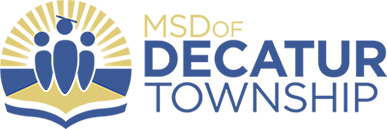Secondary Learning Outcomes
Secondary-Level Outcomes
Content and Knowledge (Subject Matter)
As defined by the Indiana Academic Standards…
Work Ethic and Attitude (Agency)
Students understand how to practice and understand how effort helps them to improve. They often take risks in their learning (take on challenges, above and beyond, etc.). Students work through challenges before asking for help. They build confidence from their strength, and see failures and challenges opportunities for growth.
Students complete assignments and benchmarks on time. They accept feedback and use that feedback to improve their work. Students are able to use a variety of strategies for tackling a task. They actively participate in class discussions and activities. They have developed a set of strategies for remaining focused and on- task during work time.
Students get started on tasks without prompting from the teacher. They build positive relationships with others and feel comfortable asking others for help. They actively work to improve skills through practice and effort, and independently reflect on their actions, decision-making, and learning (strengths, areas for growth, needs, etc.).
Students confidently seek out resources and supports when needed in order to create higher quality work. They actively seek feedback from others in order to revise their work. In addition, they monitor the effectiveness of strategies used for tackling a task and are able to adjust as needed.
Collaboration (Teamwork)
Staff and students come to our schools daily with an intense curiosity and the desire to gain an understanding beyond their own experience. They come from every walk of life, and beyond. Instead of working on different pieces of the same project, they want to explore the the innovation process together, leveraging their differences as a tool rather than problem. The collaborative thinking process becomes an adhesive that holds teams together, allowing students to release creative thoughts, and new ways of looking at old problems.
The staff and students desire for teachers and teams of teachers to combine contrasting view points and problem-solving approaches. They desire for classes to be team taught by a combination of faculty, industry leaders, and stakeholders who combine disciplines like engineering with biology, and local business owners with high school teachers. We trust these dynamic relationships encourage students to see the open-ended nature of innovation and to trust themselves to find their own path in the educational process.
Staff and students believe in “teaching and doing”. Our culture of collaboration means we disrupt the status quo. We help each other even if it’s inconvenient. They ask for inspiration when they are stuck. And they defer judgment and assume good intent long enough to build on each other’s ideas. This type of teaching and learning will lead to the creation of highly engaging activities, materials, and settings for learning that are too good—too interesting—for students to resist AND increase student achievement. By providing students access to personalized learning opportunities and customized pathways, students will graduate college and career ready.
Critical Attributes of Secondary-Level Outcomes
- Effective Leaders: The principal works with teachers to implement a clear and strategic vision for school success.
- Collaborative Teachers: The staff is committed to the school, receives strong professional development, and works together to improve the school.
- Involved Families: The entire school staff builds strong relationships with families and communities to support learning.
- Supportive Environment: The school is safe and orderly. Teachers have high expectations for students. Students are supported by their teachers and peers.
- Ambitious Instruction: Classes are academically demanding and engage students by emphasizing the application of knowledge.




%20sized.png)



